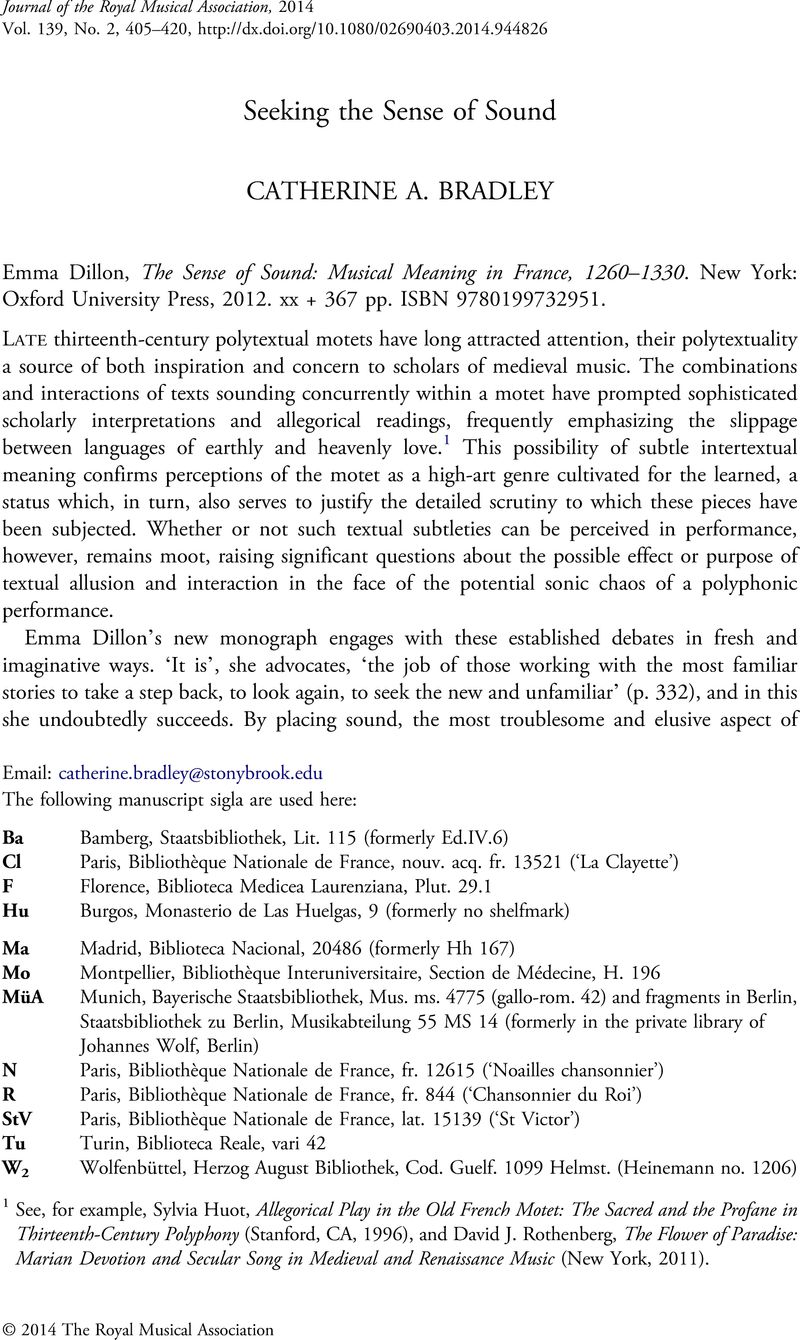Published online by Cambridge University Press: 01 January 2014

The following manuscript sigla are used here: Ba
Bamberg, Staatsbibliothek, Lit. 115 (formerly Ed.IV.6)
ClParis, Bibliothèque Nationale de France, nouv. acq. fr. 13521 (‘La Clayette’)
FFlorence, Biblioteca Medicea Laurenziana, Plut. 29.1
HuBurgos, Monasterio de Las Huelgas, 9 (formerly no shelfmark)
MaMadrid, Biblioteca Nacional, 20486 (formerly Hh 167)
MoMontpellier, Bibliothèque Interuniversitaire, Section de Médecine, H. 196
MüAMunich, Bayerische Staatsbibliothek, Mus. ms. 4775 (gallo-rom. 42) and fragments in Berlin, Staatsbibliothek zu Berlin, Musikabteilung 55 MS 14 (formerly in the private library of Johannes Wolf, Berlin)
NParis, Bibliothèque Nationale de France, fr. 12615 (‘Noailles chansonnier’)
RParis, Bibliothèque Nationale de France, fr. 844 (‘Chansonnier du Roi’)
StVParis, Bibliothèque Nationale de France, lat. 15139 (‘St Victor’)
TuTurin, Biblioteca Reale, vari 42
W2Wolfenbüttel, Herzog August Bibliothek, Cod. Guelf. 1099 Helmst. (Heinemann no. 1206)
1 See, for example, Sylvia Huot, Allegorical Play in the Old French Motet: The Sacred and the Profane in Thirteenth-Century Polyphony (Stanford, CA, 1996), and David J. Rothenberg, The Flower of Paradise: Marian Devotion and Secular Song in Medieval and Renaissance Music (New York, 2011).
2 See the openings of Johan Huizinga, The Autumn of the Middle Ages, trans. Rodney J. Payton and Ulrich Mammitzsch (Chicago, IL, 1996), and Reinhard Strohm, Music in Late Medieval Bruges (Oxford, 1985).
3 See Christopher Page, ‘Around the Performance of a Thirteenth-Century Motet’, Early Music, 28 (2000), 343–57.
4 See Friedrich Gennrich, Bibliographie der ältesten französischen und lateinischen Motetten, Summa musicae medii aevi, 2 (Darmstadt, 1957).
5 Dillon mistakenly presumes the priority of a clausula in StV over its related motet (pp. 161–3). The recent study of this manuscript by Fred Büttner has convincingly established all 40 of its clausulae as transcribed motets. See his Das Klauselrepertoire der Handschrift Saint-Victor (Paris, BN, lat. 15139): Eine Studie zur mehrstimmigen Komposition im 13. Jahrhundert (Lecce, 2011).
6 The copy in Mo omits the word ‘jolis’ in line 4 of the triplum, and has the word ‘Deum’ rather than ‘Dominum’ (as found in all other copies, and with the required number of syllables) in line 4 of the motetus. In all examples given here, ligatures are indicated by square brackets, conjuncturae by dashed slurs; plicas are shown by a line through the stem; and original text spellings are retained. Capitalization, punctuation and text-line numbers are editorial.
7 See, for example, Example 3 below, in which the repetition of the tenor melody in perfection 13 is obscured: it occurs in the middle of a motetus phrase and falls at a different point in the rhythmic pattern of the tenor (which is consistent throughout), prompting different harmonic and melodic responses in the upper voices.
8 See the discussion of Viderunt and Trois serors in Huot, Allegorical Play, 52–5.
9 Example 2 corrects perfections 35–6 of the triplum in Mo, which are mistakenly copied a third too low.
10 Although the term imitation is undeniably anachronistic, it more accurately describes the compositional features of this motet than the techniques associated with color or rondellus, phenomena discussed by thirteenth-century theorists, but principally involving an exchange of material between voices, rather than overlapping or near-simultaneous presentations of the same music.
11 The shared texts between the upper voices of Riens ne puet / Riens ne puet attracted the attention of F. Alberto Gallo in his Music of the Middle Ages II (Cambridge, 1985), 24–5. Mark Everist also commented briefly on the coincidence of musical and textual imitation in this motet. See his French Motets in the Thirteenth Century: Music, Poetry and Genre (Cambridge, 1994), 171.
12 Friedrich Ludwig argues convincingly for the priority of the French motet over its related Latin contrafactum. See his Repertorium organorum recentioris et motetorum vetustissimi stili, 2 vols. in 3 (Halle, 1910); repr. and ed. Luther Dittmer (New York, 1964, 1972 and 1978), i/2, 369.
13 Example 3 omits an extra syllable of text, ‘do’, incorrectly inserted before ‘durer’ in line 10 of the motetus in Mo.
14 See the catalogue of refrains in Nico van den Boogaard's Rondeaux et refrains du XII esiècle au début du XIV e, Bibliothèque française et romane, Série D: Initiation, textes et documents, 3, (Paris, 1969). Refrain no. 673 is transmitted with the same musical and textual material in three further motets, two of which are also recorded in Mo (M29 and M284) and one of which is unique to MüA (M80). The refrain is transposed up a fifth – beginning and ending on e – in M284 and M80. (Motet numbers refer to those in Gennrich's Bibliographie.)
15 Christopher Page has also commented on the voice exchange in this motet (although without acknowledging that one of the elements involved constitutes a refrain), describing it as a ‘motet composer's demand for attention’. See his Discarding Images: Reflections on Music and Culture in Medieval France (Oxford, 1993), 102.
16 The overall sonorities of each version differ slightly, however, because the music of the two upper voices reappears over a different portion of the underlying tenor melody. The tenor structure in this motet is unusual, since two components of the chant melisma are treated independently: the EIUS portion of the melisma is presented twice in succession, followed by the melisma on ORIENTE, which itself is then repeated (presentations of the ORIENTE melisma are marked Ia and IIa in Example 3).
17 Suzannah Clark has also drawn attention to the relationship between quoted refrains in motets and songs within songs. See her ‘“S'en dirai chançonete”: Hearing Text and Music in a Medieval Motet’, Plainsong and Medieval Music, 16 (2007), 31–59.